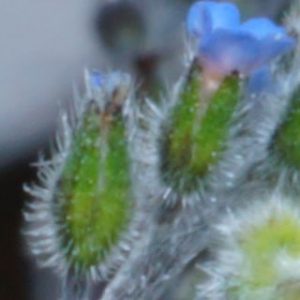 Let’s have some fun here. This time, we will focus on the difficulty in identifying the species of plants. I found a large patch of plants next to a parking area in “Oldtown” Elkridge. It was obvious to me that they were forget-me-nots (Myosotis sp.) But I was not sure of which species it was.
Let’s have some fun here. This time, we will focus on the difficulty in identifying the species of plants. I found a large patch of plants next to a parking area in “Oldtown” Elkridge. It was obvious to me that they were forget-me-nots (Myosotis sp.) But I was not sure of which species it was.
So, what shall we do to figure out what species this is? For this we will consult the Myosotis key in Alan Weakley’s Flora of the Southern and Mid-Atlantic States, 2015. There are other keys avaialble, but for the purpose of this article, we will stick with this one. (See bottom of the page of the excerpt of the key).
 The first choice in the key deals with the pubescence on the calyx:
The first choice in the key deals with the pubescence on the calyx:
1 Calyx strigose, the hairs neither spreading nor uncinate.
-OR-
1 Calyx with some loose or spreading, uncinate hairs.
Okay, strigose means short and appressed, the hairs of which on our Myosotis are not. Furthermore, at least some of the calyx hairs seem to be uncinate, meaning they are like hooks. So we will go with the second one in the pair.
The next choice is as follows:
3 Corolla limb 5-8 mm wide; perennial
– OR –
3 Corolla limb 1-4 mm wide; annual or biennial.
Our plants are not perennial and the corolla limb was measured to be less than than 5 mm. So the second one of this pair fits better.
Going down the key, this is the next choice:
4 Calyx lobes unequal, 3 lobes shorter than the other 2; corolla white; [native, of dry or moist habitats].
– OR –
4 Calyx lobes equal, all 5 the same size; corolla blue (occasionally yellow or white); [alien, mostly of dry disturbed habitats].
Right off, the corolla lobes are equal and the same size, the corolla is blue, and the habitat is disturbed. So we have to go with the second one of the pair.
Here is the next choice.
6 Fruiting pedicels equaling or generally longer than the calyx
– OR –
6 Fruiting pedicels distinctly shorter than the calyx.
Okay, this is a bit problematic. That is because the plants are in an early stage of blooming and there are not many fruiting pedicels to look at. The ones that are visible seem to be shorter than that the calyces, but the pedicels could end up being longer than the calyces as the plants mature. Identifying the plants at this point would be not much more than a guess. (There are three possibilities based on this key – Myosotis arvensis, Myosotis discolor, and Myosotis stricta.)
So for now, let’s wait for a week or two and go back to this location to see if the pedicels will be longer. (They are not going anywhere.) Then we can look at the key again. There are three possible species left in the key, and after we figure out if the pedicels stay shorter than the calyces or not, we will be able to be more confident about determining which species this is.
(Continued in Part 2)

(Used with permission of author.)
2 Replies to “14 April 2017 – Forget-me-not or not – Part 1”
Leave a Reply
You must be logged in to post a comment.

Great post, Bill – thanks! I need to go back and visit my myosotis patch again, too. Now I know to look for fruiting pedicels. BTW, you might be amused by my similar post from last year, “Weakley Flora to the Rescue!” (search on that phrase on my blog). It’s in much the same vein.